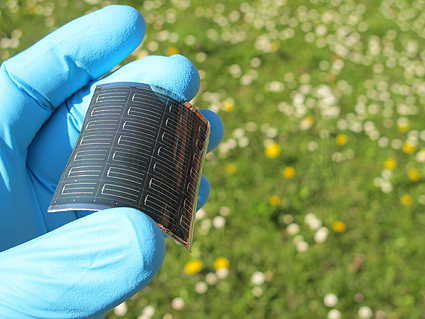May
24
New Record Set For Flexible Solar Cells
May 24, 2011 | 2 Comments
Swiss Federal Laboratories for Materials Science and Technology scientists at Empa have further boosted the energy conversion efficiency of flexible photovoltaic solar cells made of copper indium gallium (di)selenide (also known as CIGS) to a new world record of 18.7 percent. The same team achieved the previous record of 17.6 percent in June 2010 making this gain 6.25%.
Moreover the measurements have been independently certified by the Fraunhofer Institute for Solar Energy Systems in Freiburg, Germany.
Record efficiencies of up to 17.5% on steel foils covered with impurity diffusion barriers have been achieved with polycrystalline silicon (Si) wafer (the CIGS) growth processes at temperatures exceeding 550°C. But when applied to steel foil without any diffusion barrier, the proprietary low temperature CIGS deposition process for polymer films developed at Empa and FLISOM, a start-up company who is scaling up and commercializing the technology, easily matched the performance achieved with high-temperature procedure, resulting in an efficiency of 17.7%.
The latest improvements in cell efficiency were made possible through a reduction in recombination losses by improving the structural properties of the CIGS layer and the proprietary low-temperature deposition process for growing the layers as well as in situ doping with Na (sodium) during the final stage. With these results, polymer films have for the first time proven to be superior to metal foils as a carrier substrate for achieving highest efficiency.
The results suggest that commonly used barrier coatings for detrimental impurities on metal foils would not be required. Team Leader at Empa, Ayodhya N. Tiwari said, “Our results clearly show the advantages of the low-temperature CIGS deposition process for achieving highest efficiency flexible solar cells on polymer as well as metal foils.”
The background is the Empa team has been working closely with scientists at FLISOM, who is scaling up and commercializing the technology, making significant progress in low-temperature growth of CIGS layers yielding flexible CIGS cells that are ever more efficient, up from a record value of 14.1% in 2005 to the new “high score” of 18.7% for any type of flexible solar cell grown on polymer or metal foil.
The thin film photovoltaic technology based on glass substrates has gained maturity to industrial production. But flexible CIGS technology is still an emerging field. The recent improvements in efficiency in research labs and pilot plants – among others by Tiwari’s group, first at ETH Zurich and over the past two years at Empa – are contributing to performance improvements and to overcoming manufacturability barriers.
The drive for flexible high-performance CIGS solar cells is the potential to lower manufacturing costs through roll-to-roll processing while at the same time offering a much higher efficiency than panels currently on the market. The lightweight and flexible solar modules offer additional cost benefits in terms of transportation, installation, structural frames for the modules etc., effecting a significantly reduced the “balance of system” costs. Taken together, the new CIGS polymer cells exhibit numerous advantages for applications such as facades, solar farms and portable electronics.
The new high-performance technology with the recently developed processes and concepts puts within reach industrial production of monolithically interconnected flexible CIGS solar modules with efficiencies above 16%.
It’s all about money. To make solar electricity affordable on a large scale, scientists and engineers worldwide have long been trying to develop a low-cost solar cell, which is highly efficient, easy to manufacture and has high throughput.
Tiwari is convinced that, “flexible and lightweight CIGS solar cells with efficiencies comparable to the “best-in-class” will have excellent potential to bring about a paradigm shift and to enable low-cost solar electricity in the near future.”
Getting off glass and on to a lower cost and more robust supporting base at lower cost will help. A lower cost coming into the market with field efficiency of 16% will pull a lot more purchases and more photovoltaic solar cell investment.
The test is getting to mass production scale at costs that promote large sales. Photovoltaic has an advantage that could be exploited in that the “balance of costs”, or the inverter, hardware, storage, wiring and other expenses are about the same whatever solar cell is installed and should be permanent emplacements whatever solar cell is installed. These costs are also not so vulnerable to risks like wind and hail.
The cheapest part of a photovoltaic solar installation has to be the collectors. Gains in reducing costs cuts prices and risks, Gains in efficiency reduce the total exposure. Now 6.25% doesn’t sound so small.
Tiwari can be reached with the information on the Empa press release page.
Comments
2 Comments so far



[…] […]
[…] New Record Set For Flexible Solar Cells | New Energy and Fuel Swiss scientist have raised the flexible photovoltaic solar cell efficiency to 18.7%, a new world record. The cells are close to silicon at much lower cost. […]